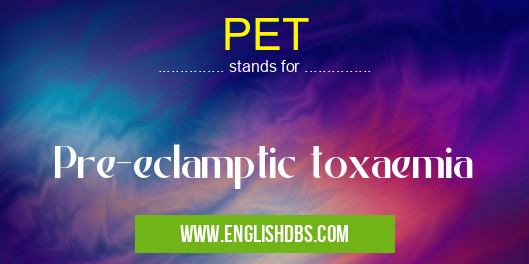What does PET mean in MEDICAL
Pre-eclampsia, also known as toxemia of pregnancy, is a serious maternal complication of pregnancy that is associated with hypertension and proteinuria. Pre-eclampsia is a medical condition characterized by high blood pressure and excess protein in the urine after 20 weeks of gestation. Pre-eclampsia can lead to severe complications, including preterm delivery, fetal growth retardation, intrauterine fetal death, placental abruption and maternal mortality. As such, it is important to identify women at risk for pre-eclampsia as early as possible. The acronym PET (Pre-Eclamptic Toxaemia) is used to refer to pre-eclampsia.

PET meaning in Medical in Medical
PET mostly used in an acronym Medical in Category Medical that means Pre-eclamptic toxaemia
Shorthand: PET,
Full Form: Pre-eclamptic toxaemia
For more information of "Pre-eclamptic toxaemia", see the section below.
Definition
PET stands for Pre-Eclamptic Toxaemia which refers to the medical condition of pre-eclampsia. It is characterised by high blood pressure and an excess amount of protein in the urine after 20 weeks into gestation. This condition places both the mother and baby at risk for further complications throughout the pregnancy.
Risk Factors
The exact cause of pre-eclampsia remains unknown but there are some factors associated with an increased risk for developing pre-eclampsia including advanced age (over 35 years old), obesity, chronic hypertension or diabetes prior to or during pregnancy, multiple pregnancies such as twins or triplets and carrying a male fetus. Women who have had preexisting kidney disorders or women who have had gestational diabetes in a previous pregnancy are also at an increased risk for developing PET. Additionally, having certain medical conditions such as lupus or antiphospholipid syndrome increases the chance of developing PET during pregnancy.
Symptoms
There are several signs and symptoms related to PET including swelling in the hands and feet due to fluid retention known as edema, headaches, nausea/vomiting, sudden weight gain due to fluid retention along with other body changes such as vision disturbances due to retinal artery spasm or impaired liver function reflected by higher levels of liver enzymes.
Treatment
In most cases of PET treatment involves close monitoring throughout the remainder of the pregnancy combined with lifestyle modifications such as rest and reduced activity levels if needed to help reduce stress on both mother and baby. Medications may be prescribed depending on severity level such as low dose aspirin therapy which helps reduce clot formation within blood vessels leading back to heart from placenta helping prevent any further complications from arising while carrying mother’s baby.
Essential Questions and Answers on Pre-eclamptic toxaemia in "MEDICAL»MEDICAL"
What is Pre-eclamptic Toxaemia?
Pre-eclamptic Toxaemia (PET) is a complication of pregnancy that can occur late in the third trimester or shortly after delivery. It’s characterized by high blood pressure, protein in the urine, and swelling due to fluid retention. Other complications include vision changes, abnormally low levels of platelets in the blood, seizures, rapid weight gain, and kidney failure.
What are the risk factors associated with PET?
The exact cause of pre-eclamptic toxaemia is unknown, but some risk factors are associated with an increased likelihood of developing the condition. These include advanced maternal age, diseases such as diabetes or lupus or chronic hypertension, obesity, multiple gestation pregnancies (twins or more), and first time pregnancy.
How can I reduce my risk for PET?
You can reduce your risk by having regular prenatal visits so your physician can monitor your health during pregnancy. You should also maintain a healthy diet and lifestyle with regular exercise throughout the course of your pregnancy to keep your body in balance. Additionally, if you have a higher risk based on certain medical conditions/risks it is important to discuss these risks with you doctor so they can develop a personalized plan for managing them during your pregnancy.
What are the signs and symptoms of PET?
Common signs and symptoms associated with pre-eclamptic toxaemia include high blood pressure (hypertension), swelling due to fluid retention (edema), headaches that don’t go away even after taking medications; sudden weight gain; changes in vision; abnormal levels of proteins in urine; decreased platelet counts; nausea and vomiting; abdominal pain; fatigue; shortness of breath; confusion and seizures
How is PET diagnosed?
To diagnose pre-eclamptic toxaemia, doctors may use physical exams to check blood pressure and look for signs of swelling as well as tests such as urinalysis and blood tests looking for elevated levels of proteins or other indicators which could be suggestive this condition exists. Ultrasound scans may also be used to assess placental function and fetal growth if indicated by individual patient's health history/presenting concerns.
What kind of treatment will I need for PET?
Treatment depends on how severe the disease is. Your doctor will work out an individualized approach for you which could involve bed rest at home or a hospital stay depending on severity as well as medications including antihypertensives (lowering blood pressure). Regular monitoring will also be conducted to ensure progress is being made or identify any new issues that arise over time.
Can PET affect my baby’s health?
While pre-eclamptic toxaemia causes no direct harm to fetus it has been linked to various complications such as growth restriction due to placental insufficiency secondary to maternal illness resulting in delays in postnatal development along with an increased risk for stillbirths or premature delivery depending on severity.
Final Words:
Pre eclampic toxaemia (PET) is a serious medical complication seen during late stages of pregnant women’s lives where one should take extra caution if experiencing any symptoms even if it doesn’t seem that dangerous at first glance. Early diagnosis and proper management would help decrease any further risks involved when dealing with this potentially life threatening condition thus requiring more attention being payed towards understanding different factors affecting development of this issue so that appropriate approaches could be taken proactively before interventions have become necessary.
